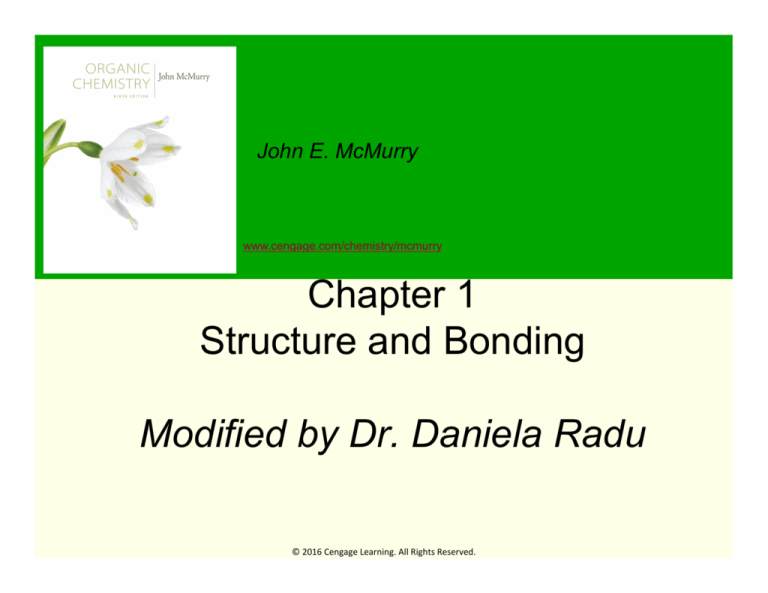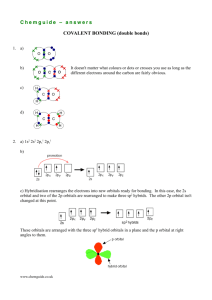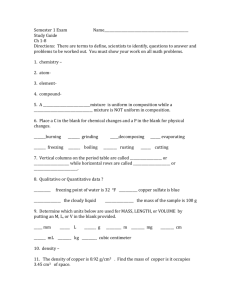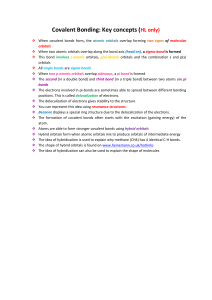
John E. McMurry
www.cengage.com/chemistry/mcmurry
Chapter 1
Structure and Bonding
Modified by Dr. Daniela Radu
© 2016 Cengage Learning. All Rights Reserved. What is Organic Chemistry?
§ Living things
are made of
organic
chemicals
§
§
§
Proteins that
make up hair
DNA
Foods and
medicines
© 2016 Cengage Learning. All Rights Reserved. Origins of Organic Chemistry
§ Foundations date from mid-1700’s
§ Compounds obtained from plants and animals
§ Low-melting solids
§
Hard to isolate, purify, and work with
§ Organic compounds were considered to have
some vital force as they were from living sources
§
Thought that it could not be synthesized in
laboratory
© 2016 Cengage Learning. All Rights Reserved. Origins of Organic Chemistry
§ 1816, Chevreul found that soap can be
separated into several organic compounds
which he termed fatty acids
§ 1828, Wöhler showed that it was possible to
convert inorganic salt ammonium cyanate into
organic substance urea
© 2016 Cengage Learning. All Rights Reserved. Organic Chemistry
§ Study of carbon compounds
§ More than 50 million known chemical
compounds contain carbon
§ Carbon is a group 4A element
§
§
§
Can share 4 valence electrons and form 4
covalent bonds
Able to bond with one another to form long chains
and rings
Only element that has the ability to form immense
diversity of compounds
© 2016 Cengage Learning. All Rights Reserved. Figure 1.1 - The Position of
Carbon in the Periodic Table
© 2016 Cengage Learning. All Rights Reserved. Atomic Structure - The Nucleus
§ Positively charged
§ Surrounded by a cloud of negatively charged
electrons (at a distance of 10-10 m)
§ Consist of subatomic particles
§ Protons, positively charged
§
Neutrons, electrically neutral
© 2016 Cengage Learning. All Rights Reserved. Atomic Structure - The Nucleus
§ Diameter of an atom is about 2×10-10 m
§ 200 picometers (pm) [the unit ångström (Å) is
10-10 m = 100 pm]
© 2016 Cengage Learning. All Rights Reserved. Atomic Number and Atomic
Mass
§ Atomic number (Z) - Number of protons in an
§
§
§
§
atom's nucleus
Mass number (A) - Number of protons plus
neutrons
Atoms of a given element have the same atomic
number
Isotopes: Atoms with the same atomic number
but different mass numbers
Atomic mass (atomic weight) - Weighted
average mass in atomic mass units (amu) of an
element’s naturally occurring isotopes
© 2016 Cengage Learning. All Rights Reserved. Atomic Structure - Orbitals
§ Wave equation - Mathematical equation which
describes the behavior of a specific electron in
an atom
§
§
Wave function, or orbital, is the solution of wave
equation
Denoted by the Greek letter psi (Ψ)
§ Plot of ψ2 describes where an electron is most
likely to be
§ An electron cloud has no specific boundary
§
Most probable area is considered
© 2016 Cengage Learning. All Rights Reserved. Atomic Structure - Orbitals
§ s, p, d, and f are different kinds of orbitals
§ s and p orbitals are common in organic and
biological chemistry
§ s orbitals - Spherical, nucleus at center
§ p orbitals - Dumbbell-shaped, nucleus at middle
§ d orbitals - Elongated dumbbell-shaped, nucleus
at center
© 2016 Cengage Learning. All Rights Reserved. Atomic Structure - Orbitals
§ Orbitals in an atom are organized into different
electron shells
§
Centered around the nucleus in shells of
increasing size and energy
§ Different shells contain different numbers and
kinds of orbitals
§ Each orbital can be occupied by two electrons
© 2016 Cengage Learning. All Rights Reserved. Figure 1.4 - The Energy Levels
of Electrons in an Atom
© 2016 Cengage Learning. All Rights Reserved. P-Orbitals
§ Each shell consists of three mutually
perpendicular p orbitals
§
Denoted px, py, and pz
§ Node: Region of zero electron density
§ Separates two lobes of each p orbital
© 2016 Cengage Learning. All Rights Reserved. Atomic Structure: Electron
Configurations
§ Ground-state electron configuration: Listing
of orbitals occupied by an atom’s electrons
§
Called lowest-energy arrangement
§ Rules
§ Lowest-energy orbitals fill first, in the order of 1s
→ 2s → 2p → 3s → 3p → 4s → 3d
§
Aufbau principle
© 2016 Cengage Learning. All Rights Reserved. Atomic Structure: Electron
Configurations
§ Electrons act as if they were spinning around an
axis
§
§
Spin can have only two orientations, up (↑) and
down (↓)
Only two electrons can occupy an orbital, and
they must be of opposite spin
§
Pauli exclusion principle
§ If two or more empty orbitals of equal energy are
available, electrons occupy each with parallel
spins until all orbitals have one electron
§
Hund's rule
© 2016 Cengage Learning. All Rights Reserved. Worked Example
§ Give the ground-state electron configuration for
sulfur
§ Solution:
§
Atomic number of sulfur is 16
§
Number of electrons = 16
In a more concise way it can
be written as
1s2 2s2 2p6 3s2 3p4
© 2016 Cengage Learning. All Rights Reserved. Worked Example
§ How many electrons does magnesium have in
its outermost electron shell?
§ Solution:
§
§
§
Elements of the periodic table are organized into
groups based on the number of outer-shell
electrons each element has
Using the periodic table we locate the group of
the element, magnesium
Magnesium - Group 2A
§
Has two electrons in its outermost shell
© 2016 Cengage Learning. All Rights Reserved. Development of Chemical
Bonding Theory
§ Kekulé and Couper independently observed that
carbon is tetravalent
§ Jacobus Van't Hoff and Le Bel proposed that the
four bonds of carbon have specific spatial
directions
§
Atoms surround carbon at corners of a regular
tetrahedron
© 2016 Cengage Learning. All Rights Reserved. Figure 1.6 - A Representation of a
Tetrahedral Carbon Atom
© 2016 Cengage Learning. All Rights Reserved. Development of Chemical
Bonding Theory
§ Atoms form bonds because the resulting
compound is more stable than the separate
atoms
§ Valence shell: Atom’s outermost shell
§
Impart special stability to the noble gas elements
§ Ionic bonds - Ions held together by a
electrostatic attraction
§
Formed as a result of electron transfers
§ Covalent bond: Formed by sharing of electrons
§
Organic compounds have covalent bonds from
sharing electrons
© 2016 Cengage Learning. All Rights Reserved. Development of Chemical
Bonding Theory
§ Molecule: Neutral collection of atoms held
together by covalent bonds
§ Electron-dot structures: Represents valence
shell electrons of an atom as dots
§
Called Lewis structures
§ Line-bond structures: Indicates two-electron
covalent bond as a line drawn between atoms
§
Called Kekulé structures
© 2016 Cengage Learning. All Rights Reserved. Development of Chemical
Bonding Theory
© 2016 Cengage Learning. All Rights Reserved. Development of Chemical
Bonding Theory
§ Number of covalent bonds an atom forms
depends on the number of additional valence
electrons it needs to reach a stable octet
§ Carbon has four valence electrons (2s2 2p2),
forming four bonds
§ Nitrogen has five valence electrons (2s2 2p3),
forming three bonds
© 2016 Cengage Learning. All Rights Reserved. Non-Bonding Electrons
§ Lone pair - Valence electrons not used in
bonding
§ Example
§
Nitrogen atom in ammonia (NH3)
§
§
Shares six valence electrons in three covalent bonds
Two valence electrons are nonbonding lone pair
© 2016 Cengage Learning. All Rights Reserved. Worked Example
§ Draw a molecule of chloroform, CHCl3, using
solid, wedged, and dashed lines to show its
tetrahedral geometry
§ Solution:
© 2016 Cengage Learning. All Rights Reserved. Valence Bond Theory
§ Covalent bond forms when two atoms approach
each other closely so that a singly occupied
orbital on one atom overlaps a singly occupied
orbital on the other atom
§
§
H–H bond results from the overlap of two singly
occupied hydrogen 1s orbitals
H–H bond is cylindrically symmetrical, sigma (σ)
bond
© 2016 Cengage Learning. All Rights Reserved. Valence Bond Theory
§ Reaction 2 H· → H2 releases 436 kJ/mol
§ H–H has a bond strength of 436 kJ/mol
(1 kJ = 0.2390 kcal; 1 kcal = 4.184 kJ)
© 2016 Cengage Learning. All Rights Reserved. Valence Bond Theory
§ Bond length: Ideal distance between nuclei that
leads to maximum stability
§
§
If too close, they repel
If too far apart, bonding is weak
© 2016 Cengage Learning. All Rights Reserved. sp3 Orbitals and the Structure of
Methane
§ Carbon has 4 valence electrons (2s2 2p2)
§ In CH4, all C–H bonds are identical (tetrahedral)
§ sp3 hybrid orbitals: s orbital and three p
orbitals combine to form four equivalent,
unsymmetrical, tetrahedrally oriented orbitals
© 2016 Cengage Learning. All Rights Reserved. sp3 Orbitals and the Structure of
Methane
§ sp3 orbitals in a C atom overlap with 1s orbitals
of an H atom to form four identical C–H bonds
§ Each C–H bond has a strength of 439 kJ/mol
and a length of 109 pm
§ Bond angle: Formed between two adjacent
bonds
© 2016 Cengage Learning. All Rights Reserved. sp3 Orbitals and the Structure of
Ethane
§ Two C’s bond to each other by σ overlap of an
sp3 orbital from each
§ Three sp3 orbitals on each C overlap with H 1s
orbitals to form six C–H bonds
§
§
C–H bond strength in ethane is 421 kJ/mol
C–C bond is 154 pm long and strength is 377 kJ/
mol
§ Bond angles of ethane are tetrahedral
© 2016 Cengage Learning. All Rights Reserved. Figure 1.12 - The Structure
of Ethane
© 2016 Cengage Learning. All Rights Reserved. Worked Example
§ Draw a line-bond structure for propane,
CH3CH2CH3
§
Predict the value of each bond angle, and
indicate the overall shape of the molecule
§ Solution:
§ Geometry - Tetrahedral
§ Bond angles - 109°(approximately)
© 2016 Cengage Learning. All Rights Reserved. sp2 Orbitals and the Structure of
Ethylene
§ sp2 hybrid orbitals: Derived by combination of
an s atomic orbital with two p atomic orbitals
§ sp2 orbitals are in a plane with an angle of
120°from each other
§ Remaining p orbital is perpendicular to the plane
© 2016 Cengage Learning. All Rights Reserved. sp2 Orbitals and the Structure of
Ethylene
§ Two sp2 hybridized orbitals overlap to form a
§
§
§
§
σ bond
p orbitals interact by sideways overlap to form a
pi (π) bond
sp2–sp2 σ bond and 2p–2p π bond result in
sharing four electrons and formation of C–C
double bond
Electrons in the σ bond are centered between
nuclei
Electrons in the π bond occupy regions on either
side of a line between nuclei
© 2016 Cengage Learning. All Rights Reserved. Structure of Ethylene
§ H atoms form s bonds with four sp2 orbitals
§ H–C–H and H–C–C form bond angles of about
120°
§ C–C double bond in ethylene is shorter and
stronger than single bond in ethane
© 2016 Cengage Learning. All Rights Reserved. Worked Example
§ Draw electron-dot and line-bond structures of
formaldehyde
§
Indicate the hybridization of the carbon orbitals
§ Solution:
§ Two hydrogens, one carbon, and one oxygen can
combine in one way
§
The orbitals are sp2-hybridized
© 2016 Cengage Learning. All Rights Reserved. sp Orbitals and the Structure of
Acetylene
§ Carbon can form a triple bond sharing six
electrons
§ Carbon 2s orbital hybridizes with a single p
orbital giving two sp hybrids
§
Two p orbitals remain unchanged
§ sp orbitals are linear, 180°apart on x-axis
§ Two p orbitals are perpendicular on the y-axis
and the z-axis
© 2016 Cengage Learning. All Rights Reserved. Figure 1.15 - sp Hybridization
© 2016 Cengage Learning. All Rights Reserved. Orbitals of Acetylene
§ Two sp hybrid orbitals from each C form
sp–
sp σ bond
§ pz orbitals from each C form a pz–pz π bond by
sideways overlap
§
py orbitals overlap to form py–py π bond
© 2016 Cengage Learning. All Rights Reserved. Bonding in Acetylene
§ Sharing of six electrons forms C≡C
§ Two sp orbitals form σ bonds with hydrogens
§ Shortest and strongest carbon–carbon bond
© 2016 Cengage Learning. All Rights Reserved. Table 1.2 - Comparison of C–C and C–H Bonds
in Methane, Ethane, Ethylene, and Acetylene
© 2016 Cengage Learning. All Rights Reserved. Worked Example
§ Draw a line-bond structure for propyne,
CH3C≡CH
§
§
Indicate the hybridization of the orbitals on each
carbon
Predict a value for each bond angle
§ Solution:
© 2016 Cengage Learning. All Rights Reserved. Worked Example
§ C3-H bonds are σ bonds
§ Overlap of an sp3 orbital of carbon
§
3 with s orbital of hydrogen
§ C1-H bond is a σ bond
§ Overlap of an sp orbital of carbon
§
1 with an s orbital of hydrogen
§ C2-C3 bond is a σ bond
§ Overlap of an sp orbital of carbon
§
2 with an sp3 orbital of carbon 3
§ Three C1-C2 bonds
© 2016 Cengage Learning. All Rights Reserved. Worked Example
§ Bond angle
§ Between three carbon atoms is 180°
§
§
H–C1≡C2 is 180°
Between hydrogen and the sp3-hybridized carbon
is 109°
© 2016 Cengage Learning. All Rights Reserved. Hybridization of Nitrogen, Oxygen,
Phosphorus, and Sulfur
§ H–N–H bond angle in methylamine 107.1°
§ C–N–H bond angle is 110.3°
§ N’s orbitals hybridize to form four sp3 orbitals
§ One sp3 orbital is occupied by two nonbonding
electrons, and three sp3 orbitals have one
electron each
© 2016 Cengage Learning. All Rights Reserved. Hybridization of Nitrogen, Oxygen,
Phosphorus, and Sulfur
§ Oxygen atom in methanol can be described as
sp3-hybridized
§ C–O–H bond angle in methanol is 108.5
§ Two sp3 hybrid orbitals on oxygen are occupied
by nonbonding electron lone pairs
© 2016 Cengage Learning. All Rights Reserved. Hybridization of Nitrogen, Oxygen,
Phosphorus, and Sulfur
§ Methyl phosphate, CH3OPO32§ O–P–O bond angle is approximately 110 °to
112°
§
Implies sp3 hybridization in the phosphorus
orbitals
© 2016 Cengage Learning. All Rights Reserved. Hybridization of Nitrogen, Oxygen,
Phosphorus, and Sulfur
§ Dimethyl sulfide [(CH3)2S] is the simplest
example of a sulfide
§ Described by approximate sp3 hybridization
around sulfur
§ Have significant deviation from the tetrahedral
angle
© 2016 Cengage Learning. All Rights Reserved. Worked Example
§ Identify all nonbonding lone pairs of electrons in
the oxygen atom in dimethyl ether, CH3–O–CH3
§
What is its expected geometry
§ Solution:
§ The sp3-hybridized oxygen atom has tetrahedral
geometry
© 2016 Cengage Learning. All Rights Reserved. Molecular Orbital (MO) Theory
§ Description of covalent bond formation as
resulting from a mathematical combination of
atomic orbitals to form molecular orbitals
§ Bonding MO: Molecular orbital that is lower in
energy than the atomic orbitals from which it is
formed
§ Antibonding MO: Molecular orbital that is
higher in energy than the atomic orbitals from
which it is formed
© 2016 Cengage Learning. All Rights Reserved. Figure 1.17 - Molecular Orbitals
of H2
© 2016 Cengage Learning. All Rights Reserved. Molecular Orbital Theory
§ The π bonding MO is from combining p orbital
lobes with the same algebraic sign
§ The π antibonding MO is from combining lobes
with opposite signs
§ Only bonding MO is occupied
© 2016 Cengage Learning. All Rights Reserved. Drawing Chemical Structures
§ Several shorthand methods have been
developed to write structures
§ Condensed structures: C-H or C-C single
bonds are not shown, they are understood
§ Example
© 2016 Cengage Learning. All Rights Reserved. Rules for Drawing Skeletal
Structures
§ Carbon atoms aren’t usually shown
§ Carbon atom is assumed to be at each
intersection of two lines (bonds) and at the end
of each line
§ Hydrogen atoms bonded to carbon aren’t shown
§ Atoms other than carbon and hydrogen are
shown
© 2016 Cengage Learning. All Rights Reserved. Table 1.3 - Kekulé and Skeletal
Structures for Some Compounds
© 2016 Cengage Learning. All Rights Reserved. Worked Example
§ How many hydrogens are bonded to each
carbon in the following compound
§
Give the molecular formula of each substance
© 2016 Cengage Learning. All Rights Reserved. Worked Example
§ Solution:
© 2016 Cengage Learning. All Rights Reserved. Summary
§ Organic chemistry - Study of carbon compounds
§ Atom: Charged nucleus containing positively
charged protons and neutrally charged neutrons
surrounded by negatively charged electrons
§ Electronic structure of an atom is described by
wave equation
§
Different orbitals have different energy levels and
different shapes
§
s orbitals are spherical, p orbitals are dumbbellshaped
© 2016 Cengage Learning. All Rights Reserved. Summary
§ Covalent bonds - Electron pair is shared
between atoms
§ Valence bond theory - Electron sharing occurs
by the overlapping of two atomic orbitals
§ Molecular orbital (MO) theory - Bonds result
from combination of atomic orbitals to give
molecular orbitals, which belong to the entire
molecule
© 2016 Cengage Learning. All Rights Reserved. Summary
§ Sigma (σ) bonds - Circular cross-section and
are formed by head-on interaction
§ Pi (π) bonds - Formed by sideways interaction of
p orbitals
§ Carbon uses hybrid orbitals to form bonds in
organic molecules
§
§
In single bonds with tetrahedral geometry, carbon
has four sp3 hybrid orbitals
In double bonds with planar geometry, carbon
uses three equivalent sp2 hybrid orbitals and one
unhybridized p orbital
© 2016 Cengage Learning. All Rights Reserved. Summary
§
Carbon uses two equivalent sp hybrid orbitals to
form a triple bond with linear geometry, with two
unhybridized p orbitals
§ Atoms such as nitrogen and oxygen hybridize to
form strong, oriented bonds
§
Nitrogen atom in ammonia and the oxygen atom
in water are sp3-hybridized
§ Structures in which carbon–carbon and carbon–
hydrogen bonds aren’t shown are called
condensed structures
© 2016 Cengage Learning. All Rights Reserved.







